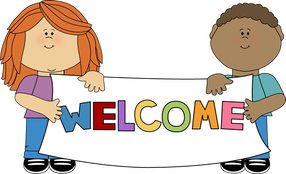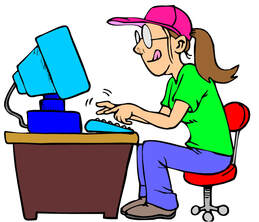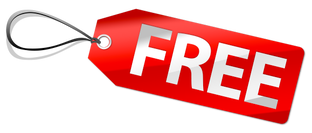Week 14 - Differentiate or Die*  Fact: there are currently over 33 million individual book titles listed on Amazon. OK, some of those are in foreign languages or their subject matter is of no interest to your readers, but even taking them into account, there is a lot of competition for the Indie author to contend with. So, two questions: 1. What can you say about your book that will make it stand out from the crowd? and 2. How can you present that message in a way that will appeal to the reader? If you can answer those two questions you have a fighting chance of selling your book. If you can’t, then I suggest taking up fishing or knitting, or anything that isn’t writing books. "you are creative with words" But you are an author. That means you are creative with words. That is a good start. But you also need to engage with other forms of creativity because words alone will no longer sell books. Back in the days when the written word was king it would suffice, but in the 21st century, written promotions are as out of date as water mills to grind corn. Think about the amount of different media that is now available and then think about the sort of content that is most popular.  If a picture is worth a thousand words, a video has to worth ten thousand. That’s why Twitter sets its character limit at 280. They know that some people don’t want to read messages that are longer than that – but those same people will watch a video. We know that because YouTube is so popular. Differentiating a product is the art of making it more appealing when compared to its competitors. Car makers do that by adding different features to their cars, changing the exterior shape or providing different colour schemes and interior finishes. Ice cream manufacturers do it by selling different flavours. Some businesses differentiate on the basis of quality (“luxury” chocolates, for example) while other differentiate on the basis of price; making their product cheaper than the competition. And the author must do it by making sure that their book is more appealing to the reader than the hundreds of similar books that are available. But authors have to do it before the reader has even sampled the product. “sell the sizzle, not the sausage”  There is a saying in the world of sales: “sell the sizzle, not the sausage”. What that means is that you have to create a vision of the product, rather than the details of what it is. Imagine a sausage (a vegan one if you wish) sizzling away in a pan, the aromas wafting through the air to reach your nose. Imagine it being placed on a plate alongside potatoes and vegetables. Imagine a piece being sliced off and being raised to someone’s lips as they start to eat. Compare that to the actual description of a sausage I found on the internet: “an item of food in the form of a cylindrical length of minced pork or other meat encased in a skin, typically sold raw to be grilled or fried before eating.” Which of those two paragraphs is going to make your mouth water and make you think about going out to buy some sausages? That is how you have to differentiate your books. Saying that your book is a love story about two strangers who meet on a train before being separated by a train crash may be factual, but it isn’t exciting. It is the equivalent of the dictionary description of a sausage. But saying “Alex and Sam were doomed to be parted. Fate had its own plans for them and it would take all their hopes and dreams to bring them together once again. That’s the sausage sizzling description. "everyone can now be a movie director"  Now, imagine that you are watching TV or perhaps YouTube and you were actually presented with the image of Alex and Sam being parted and searching for each other across whatever divides them. Wouldn’t you want to know if they find each other once again? And that is what modern technology allows us to create. Because everyone can now be a movie director. All they need is a phone, some software and a bit of imagination. You don’t even have to have the phone. You can create videos from montages of photographs or other images (providing you have the right to use them). A little bit of training is always helpful and this free course offered by Future Learn is all about creating the right content for the right audiences, Throughout this series of blogs, we have focused on social media as the way to market books, because it is free (unless you use their paid advertising services). But just because it is free it doesn’t mean that you can’t get creative with it. Microsoft Moviemaker 10 (other free film making packages are available) allows you to do a wide range of things just using slides created from Powerpoint or similar packages, but if you can create video clips with your phone's camera then you can do even more. It isn’t hard to learn to use so go, play, have fun and be creative.  If you think that making a movie is too complicated, try a podcast instead. These allow you to read extracts from your books to stimulate interest. Platforms such as Spotify for Podcasters allow you to upload your podcasts and you can promote them through your social media channels. The one difficult thing about podcasts is making sure that the listener knows which character is speaking, or whose point of view is being observed. Professional narrators often use different voice ptich or different accents, but you will have to find your own way of doing it.  But whatever media you are using for promoting your work, make sure the language is:
If you are writing for a young audience then you can use the sort of relaxed forms of language that young people use, but if your target audience is older, then more formal language may be appropriate. By tone we mean that the words you use match the type of book you have written. If your book is supposed to be humorous, you can adopt a bantering type of tone. If it is serious you have to use a more serious tone. If it is dramatic, then dramatic language is appropriate.  Record yourself saying the words and play them back to yourself. Do they sound right, in the context of the book you have written? If they don’t, your audience may be put off. They certainly won’t be engaged by what you have produced, regardless of the media you are using. Above all you have to create the “sizzle” for your book to encourage the reader to click a link and go to the place where they can buy the book. If they don’t do that then your message has failed. OK, you won’t get a click from very viewer/listener/reader, but if you get enough clicks you will get sales. There are two areas we have yet to cover in detail. First of all, if a reader wants to buy a new book but hasn’t seen any of your social media content (despite your best marketing efforts that’s still a possibility), how do you help them to find it? This is called Search Engine Optimisation (SEO). We’ll be discussing that next week.  We have covered measurement in passing, within other blogs, but it is an important subject in its own right, because if you don’t measure the right things at the right time, you’ll never know if your marketing strategy is working. And if you don’t know if it’s working, you can’t improve it. So, we’ll also be covering that in next week’s blog. * Jack Trout, marketing guru. If you have enjoyed this blog and want to make sure you don’t miss future editions, you can sign up for our newsletter. Just click the button below. Don’t be afraid, we promise not to “spam” you and if you don’t like it, you can unsubscribe later.
0 Comments
Week 10 - I Hear What You’re Saying  It doesn’t matter how many people you engage with on social media, if the messages you send them aren’t clear, they won’t buy your book. So that is the subject of this week’s blog – coming up with clear marketing messages. There are a number of ways to create content and creative people are coming up with new ways all the time. But we’ll start with the basics and you can get creative yourself once you have got the idea. If you’d like to do some training in this topic, our old friends at Future Learn offer an online course that is (yay) free and you can sign up for it anywhere in the world. We recommend it. For this blog we’re going to look at two specific types of content.  You will recall, all the way back in Week 2 of this blog, I mentioned the “elevator pitch”. I said that it wasn’t much good for approaching an agent, but it did have its uses elsewhere. Well, this is “elsewhere”. If you haven’t read that blog and don’t know what an elevator pitch is, it’s a short description of your book, designed to catch the attention of a potential audience in a very short space of time – typically the duration of a ride in an elevator, hence its name. Elevator pitches aren’t unique to the publishing world. They can be used in any interaction where you need to get an idea across quickly and concisely. Imagine you are at a party and you find yourself in conversation with a stranger. “What do you do for a living?” They ask.  “I’m an author.” you reply (because you are if you want to sell your books, no matter what you actually do to earn a living). “Oh, that’s interesting.” They say, because this is a party and they feel obliged to make small talk. “What sort of books do you write?” “Well, my latest book is …” And you launch into your elevator pitch, which is basically your book’s description in thirty to sixty seconds. Then you pause. If their eyes have glazed over and they change the subject, let it drop – don’t bore them to death with it. But if they say “Oh, that sounds intriguing,” They may ask you more and you can feel free to elaborate until they run away screaming.
there are so many available on the internet already. This is one I found quite quickly. If you don’t like that one, there are plenty more where that came from. But that elevator speech is your basic marketing message for use on social media because it is concise and easy to understand. If you can get it down to 280 characters, then it’s ideal for Twitter, but if you can’t then it can still be used on other social media.  Here’s a trick for Twitter. Turn your message into a picture. Use Powerpoint (other graphics packages are available), put your elevator pitch into a text box, insert the cover image alongside it and save it as a .jpg (image) file. All you need to do then is upload it into your Tweet and add a link so that anyone interested can click through to its retail page on whatever platform you are using for sales. But, of course, you can also use the same “slide” for other social media. But you don’t have to stop there. If you can set up a series of slides you can join them together and make them into a video using packages such as “moviemaker”. Or you can make some actual videos with yourself or family members in them. These are ideal for use on Youtube and Instagram (you could actually video yourself in a party situation, in conversation with a “party guest”). I have what is known as a “good face for radio”, which is a euphemism for being ugly, so I wouldn’t want to be in a video, but there’s nothing wrong with my voice, so I can do a voiceover for a video made up of slides  Some music helps and you can find stuff to download for free on this website. You can also find some sound effects there. You may want to edit the soundtrack or music clip, and there is a package called Audacity which can also be downloaded for free. It isn’t easy to use, so be prepared to take some time to learn how. With Audacity you can also create and edit your own podcasts and you can upload them to sites such as Spotify for Podcasters. (other websites for podcasters are available). But if you are going to do a podcast, you are going to need a lot more material than just your elevator pitch.
available on some retail platforms. Your elevator pitch provides the intro, to “hook” the listener and then the extract reels them in. I think you can see that this is all very time consuming, which is why small publishers want 50% of your royalties if you sign with them. If you are a full-time author you may have time to do all this marketing, but if you have a day job and a family to juggle, then it becomes more challenging. But if your books aren’t selling and you aren’t doing some (or all) of this stuff, then that may be one of the reasons. "But if your books aren’t selling .... that may be one of the reasons."  Next, I’m going to take a look at your book’s “blurb”. The blurb is the book’s description that appears beneath the cover image on the retail website and will also appear on the back cover of a hard copy book – or maybe on an inside page. You will find a lot of blogs about writing elevator pitches, but not nearly so many about writing blurbs. That’s because elevator pitches are mainly considered as being a tool to catch an agent’s eye. If you do that, they will find you a publisher and publishers have people who are paid to write blurbs, so the author doesn’t need to know how to do it. But you are here, reading this blog, which means you haven’t got an agent, nor a publisher who employs a blurb writer. So, you need to know how to do this for yourself. Imagine yourself walking along the street and you happen to glance sideways through a window before looking back to where you are going. After a fraction of a second your brain catches up with your feet and says “Hang on, there was something going on in there, but I don’t know what.” Well, that is the elevator pitch. Now you go back and take a proper look through the window and see someone being attacked with an axe. That is the blurb.  Like the elevator pitch, the blurb has to be concise. If it starts to go on too long the reader will lose interest and move onto another book. But it also has to tell the reader that this is a book that they will enjoy reading, which means it can’t be too short. We found this blog that provides some useful tips. They tie in well with an approach using a fishing metaphor: hook, line and sinker (it’s also the titles of the books in a trilogy by Len Deighton, but that’s another story - sorry, pun intended).  The hook is a short, snappy statement designed to catch the eye, just like the hook catches the fish (that would make the elevator pitch the “bait”). This is the sort of thing we mean: “When you’re up to your backside in alligators, it’s hard to remember that the object of the exercise was to drain the swamp.” That sort of sentence excites all sorts of questions, not least, “what does it mean?”. Thinking about your own book, what sort of short, snappy sentence or couple of sentences could you come up with that would catch the eye? Typical romance ones usually focus on unrequited love. Crime thrillers mention the bizarre nature of a murder. The hook for one of our author’s books, Operation Absolom, is “There’s an old saying in the Army, ‘Never volunteer for anything’. It has been said many times, so why on Earth did Steven Carter ignore it?” Straight away you get two things from that: The book has something to do with the Army, and also the main character’s name. But he obviously volunteers for something that he later regrets – but what is it? If you have to find out what he volunteered for, you are "hooked".  The “line” is where you flesh out the plot and characters for the reader. It will be about a paragraph in length, saying enough to keep the interest going, but not so much that you are giving the book away for free. That’s why it needs to be limited a to a paragraph in length – probably no more than 100 words. Returning to Operation Absolom, here’s the “line” we used: “After volunteering for the Army Commandos, Carter finds himself cut off in enemy occupied Norway. It’s winter, it’s cold and the enemy is hunting for him. Can he survive against all these odds? Even if the Nazis don’t capture him, can he find a way back to England?” So, now we know what Carter volunteered for and why he may now be regretting it. We are also setting up the background against which the story is told – Nazi occupied Norway. Finally, we are asking a “cliff-hanger” question – will the hero escape? If the reader wants the answer to that question, they know what they have to do.  People like to read books similar to the ones they have already read and enjoyed. It is a comfort to them – even if it is frustrating for new authors. So, if you can compare your book to well-known books that the reader may have enjoyed, it tells the reader that they might enjoy this one as well. So, the “sinker” is “If you enjoy the stories of (inset well-known author’s name) and (insert another well-known author’s name) then you will love (insert book title) by (insert author’s name). You can jazz that final paragraph up a bit more if you want, by saying things like “tenser than …. more dramatic than …. more tear jerking than ….” etc. But you don’t have to name authors. You can just use a well-known title or even a film or TV series. Our blurb for “The Deputy Prime Minister” compares it to “House of Cards” and “The West Wing”. Amazon, who know a bit about book marketing, suggest a word count of about 150 for a blurb. That’s only a target, of course, but it gives you something to aim for.  The whole idea of the blurb is to encourage the reader to “look inside” ie start reading the book, just as they might if they were standing in a bookshop with the book in their hand. If you succeed you have a better than 50:50 chance of the reader buying the book. Let’s face it, if you have got the reader this far, the only reason for not buying the book is that, based on the ‘look inside’, they don’t like it or they think it is poorly written. Which is the other main reason your book may not be selling. It doesn’t matter how much marketing you do, if the reader doesn’t like that ‘look inside’ bit, they aren’t going to buy your book. But that is for you to reflect on.
you want, but it’s not so easy to refresh your blurb. Basically you have to republish your book, so taking your time to work on your blurb is time well spent. Why not try it out on your beta readers as well? Send them two or three versions and see which one they prefer. They might even be able to suggest improvements.
Like your elevator pitch, your blurb can be used on social media. It is quite well suited for Facebook, for example, with a link to the book’s retail page so the reader can ‘look inside’, or perhaps to a website where they can get a free extract, as discussed in last week’s blog. Your blurb can be turned into a video and used as the introduction to an extract in a podcast. If you know how to do it, you could even produce an animation. The limit is your own imaginations and skills – and how much you are willing to spend on software packages. We would advise keeping things simple (and free) to start with, then perhaps re-investing some of your royalties later, once you have sold some books. Talking about selling, what should be the price of your book? That’s what we take a look at next week. If you have enjoyed this blog and found it informative and you don't want to miss an edition, make sure you sign up for our newsletter. Just click the button below. Week 8 -To Blog Or Not To Blog, That Is The Question.  As discussed last week, writing a blog is one of the ways that you can engage with potential readers in your target audience. But we’re not just talking about written blogs like this one. The term also covers things like videos on YouTube and Instagram. If you are trying to engage with a young audience, you are going to have far more success with those than you are with the written word. There are also podcasts, which are audio blogs and have a considerable following of their own, especially among people who spend a lot of time travelling. So, anything you read here about blogs, transpose to those other media as well. What is a blog? Time to look in the dictionary. I came across this definition, which is good enough for my purposes: “a regularly updated website or web page, typically one run by an individual or small group, that is written in an informal or conversational style.”
(long before the www was a twinkle in Tim Berners-Lee’s eye) its purpose was to “Inform, educate and entertain”. We couldn’t put it better ourselves. That is what your blog should aim to do. You can do just one of those three things or any combination of them. We hope this blog covers “educate” and “inform”, but if you are entertained as well, that’s a bonus. The important thing is that after reading our blog, you don’t feel you have wasted your time.  If people like your blog, they will come back again for the next one. They may even look forward to the next edition eagerly. And if they are doing that, they are almost certainly going to be interested in anything else you have written. They may even sign up to your email list so that they can keep up to date with your blogs – but be careful not to start spamming people. That’s a quick way to lose friends and followers.  Use the right tone. Use the right tone. The “tone” of your blog is very important, it says a lot about you and affects the way readers will perceive you. If your tone is too stiff and formal, then you will come across as “stuffy” and it may be assumed that your books will be stuffy too. On the other hand, if you are too chatty and informal, people may not take you seriously enough and, therefore, they may not take your books seriously. We’d be interested in hearing from you about what you think of our “tone”. Is it right for what we are trying to do? Is it too stiff and formal or is too laid back and relaxed? Or, is it something else? Feel free to use the comments section to let us know what you think. We have talked already about what interests, other than reading, your target audience might have and that is one thing you can use in your blogs. If your target audience is likely to be interested in dogs, then you can blog about dogs. If they are likely to be interested knitting, you can blog about knitting. If you have done your homework on your target audience, you will probably have come up with a list of things they may be interested in and you can blog about most of them, because you are interested in them too. We have created a list of blog prompts and you can download it at the bottom of this blog.  Where can you post your blog? There are a number of websites that will allow you to host a blog for free. Some of them might try to flog you a range of other services, such as a full-blown website, but they will let you post your blogs as well, so that’s the important thing. We Googled “free blog hosting” and came up with this list, which also happens to be a blog (though not by us). Is there anything that you shouldn’t blog about?  You are trying to make friends and there are two things that will lose you friends quite quickly: politics and religion. To that I might add climate change, veganism, gender issues, conspiracy theories and a few more. I once read the following Tweet “If I’d known that Val McDermid (a popular Scottish crime writer) was a socialist, I’d never have bought any of her books”. OK, that’s a particularly extreme viewpoint, but not untypical of the sort of narrow mindedness that exists. Venture into those fields if you feel you must, but make sure they aren’t minefields. It doesn’t matter how open-minded, reasonable or rational you think you are being; you are going to upset someone. This isn't a hard and fast rule. There are times when blogging on those sorts of issues is justified.
politics. This is particularly true if your book is aimed at people with a specific political perspective. If your books are religious themed, then you might be justified in blogging about religion. Just be careful, that’s all we are saying. You went to a lot of trouble to identify your target audience and build up a following on social media, so don’t throw it away by alienating them with one ill-advised rant about Brexit, the Pope or Greta Thunberg. You are entitled to your opinions, but not everyone will share them – even in your target audience.  It is time consuming to write blogs and that is enough to put some people off taking that route. So, it’s a good job it isn’t the only way to engage with your potential audience. There are also chat groups and discussion forums. One of the best known of these is Mumsnet so I’m going to use them as my model, even though I’m not a Mum (I am a Dad though). These groups offer the opportunity to discuss a wide range of topics that are of common interest. It is probable that if you try to plug your book there you will get kicked off, but a popular topic for discussion is “what to do during maternity leave” (as if raising a child wasn’t enough) and that is where you can drop into the conversation that a good way of using time is to write a book. You can also discuss books by other authors quite legitimately, under the appropriate thread(s). That at least allows you to let it be known that you are interested in books. "you try to plug your book there and you will get kicked off" The aim of using these chatrooms is to attract new followers to your other social media channels, where you can and do plug your books. And that is what happens when you engage with people. You turn them into friends and friends stay in touch. I’m a keen golfer myself. In researching this blog (yes, we do that), I discovered that there are some golf forums that run like Mumsnet. We also happen to publish a book about golf. Guess who’s going to join a couple of those fora as soon as they have enough time between writing blogs, promoting books and editing.  Now onto another popular way of engaging with your readers. The “freebie” or “teaser”. It is another strand of “engagement”, but one that is a bit more direct in its approach. The idea of the teaser is for potential readers to look at your work before they buy it. This ability already exists on some retail platforms with “look inside” or similar features. But they rely on you having a manuscript (MS) uploaded to the platform and on sale. What if you are still a few weeks away from getting the final version ready for launch? You want to start engaging your audience’s interest, but the MS isn’t yet ready for publication. It also relies on people stumbling across your book on the retail platform and that is unlikely to happen. In a previous blog we pointed out that there are 4,000 new books published very day, so you are walking a busy street. There is a facility on many retail platforms for customers to pre-order. This is great for getting a boost up the sales rankings on Amazon and other sites. If your books have been pre-ordered, then all the pre-orders get counted on the day the book goes “live”. That can catapult you up the sales rankings, which means that your book might feature in the “best-sellers” list for the day which, in turn, can lead to more sales. This is known as “momentum”.
you set up the pre-order. You can set the pre-order up a year in advance. That’s great for well-established authors who already have a loyal following eagerly awaiting the next book but, for you, a month or two in advance is all you need. But why should anyone pre-order a book when they don’t know if they will like it? Because if there’ no MS uploaded, there’s no “look inside” to read.  Because you have posted a teaser elsewhere and that has whetted their appetite. We encourage our authors to do this – and it works. One of our author's books got above 300 in the Amazon sales rankings for their book on the day it was released, thanks to pre-orders. OK, it isn’t quite Harry Potter – but it encouraged more sales on launch day. What is best practice for teasers? Well, whatever you offer has to engage the reader, so it really has to give them a flavour of what the book is about. If the first chapter or the first 10% of the wordcount does that, then that’s the bit to use, but you may want something a bit more dramatic, a bit more emotional or a bit more exciting, in which case you may want to cherry-pick from elsewhere in the book. You might even assemble a collage of extracts from different parts of the book – but for goodness sake don’t give away the ending. But the most important part is the last line of the extract. It has to be a “call to action”. This will include a link to the specific page on the website where the book can be bought or pre-ordered. The call to action will say something like “We hope you enjoyed this extract. You can find out more about “Book Title” by “Author Name” here. “Here” being the link to where the book can be bought or pre-ordered.  Note that the call to action didn’t use the words “buy”, “order” or “pre-order”. This is because people may feel pressured by those words. You are just being helpful by pointing them to the place where they can find out more. If they click the “purchase” button, it must be because they have made up their own mind to do that. Of course, giving people a teaser relies on having somewhere they can download it, which usually means a website, but some social media does allow you to post things that can be downloaded. Here at Selfishgenie we have a specific Free Stuff page where our authors can post their teasers and we promote them through our social media and they promote them through theirs. There is also a website called Wattpad where you can post extracts (or even complete books) and link them to other social media or websites. Or you can post your freebie as a blog on one of the websites that allows free blog hosting. In last week’s edition of this blog, we used an almost throwaway line when we said that YA readers are mainly online between 7 and 10 pm and that’s when you may be drinking your cocoa and watching Corrie and Midsomer Murders. But it isn’t such a throwaway. Reaching your audience at the right time of day is critical and we’ll be taking a closer look at that in next week’s edition. See – we even use teasers when we’re blogging. If you have enjoyed this blog and found it informative, make sure you don't miss the next edition by signing up for our newsletter. Ah, g'wan, ya know ya want ta. Just click the button.
|
AuthorThis blog is compiled and curated by the Selfishgenie publishing team. Archives
June 2025
|
||||||||||||||||||

 RSS Feed
RSS Feed